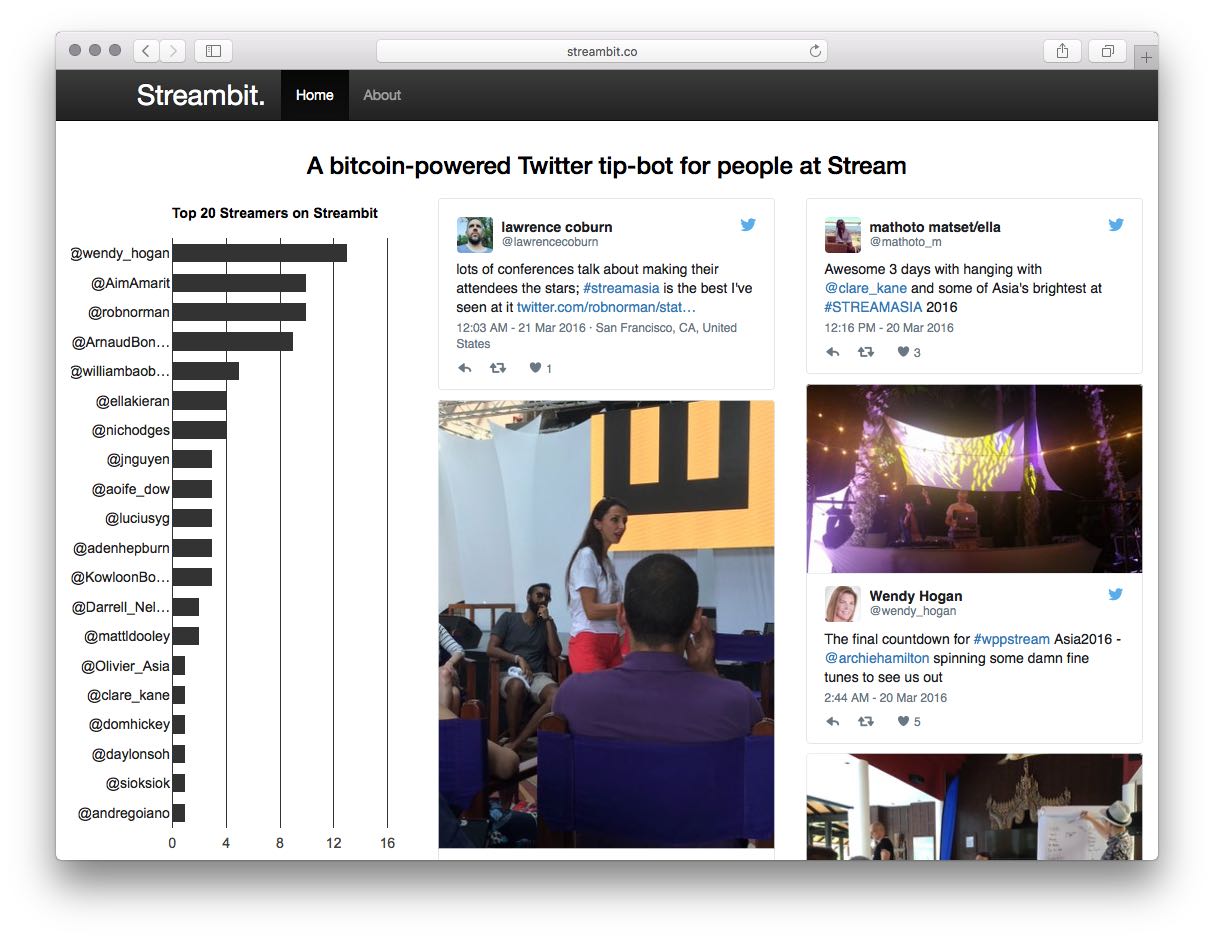Building a blockchain-powered Twitter tip-bot for WPP’s Stream unconference
In March I spent a few days in Phuket, at WPP’s Stream Asia conference. Stream is one of the best conferences in the world, combining great people, big thinking, and a lot of amazing ideas.
One of the highlights of Stream is The Gadgethon - an opportunity for participants to get up on stage and show off some piece of tech-nerdery they’ve built (or bought at the airport on the way in).
Knowing I’d be talking about Bitcoin and blockchains during the conference, and given messaging bots seem to be on-trend, I decided to build a blockchain-powered Twitter tip-bot, and launch it at The Gadgethon.
So Streambit was born. Streambit is a bot that rewards participants at Stream for sharing. Those rewards have real value, in the form of Bitcoin.
So how exactly does that work? Streambit constantly monitors Twitter, looking for interactions between people at Stream - a @mention, or a retweet. These types of interaction act as a proxy for identifying people who are adding value at Stream.
When Streambit sees an interaction, it transfers some bitcoin to the person or people who are being mentioned or retweeted. Each person at Stream starts with a small balance of bitcoin. So these tips aren’t being issued from a central server, but rather peer-to-peer. The tip flows directly from the account of the person who tweeted to the account of the person who was mentioned or retweeted.
While Streambit was pre-populated based on the Stream website - users could also register by tweeting “@streambit hello”. What this means is that every person on Twitter who was at Stream, actually now had a Bitcoin wallet created for them, with a small balance in it.
Further interaction with the bot was possible, with commands including:
- “@streambit balance” - which would return the current balance of your account in bitcoin (ie. starting balance-tips you’ve given out-tips you’ve received)
- “@streambit deposit” - which would return a wallet address to deposit more bitcoin in to your account (for anyone who was super-keen on tweeting and got their account balance to zero)
- “@streambit withdraw ” - which would move a users current balance to another wallet address which they controlled, allowing them to spend the bitcoin they had earned however they wanted.
While being seamless, invisible and frictionless is great, being visible in some way is also important. So I threw together a simple dashboard to show the Streambit most-tipped leaderboard, and recent tweets about Stream.

Why?
The way that we recognise and reward content that we find valuable in the digital world is broken.
We need a way to acknowledge that we all get value, real value, from the abundance of content online.
We need a way to transfer that value. Even if it’s minuscule, we should be able to transfer real value in a seamless, frictionless, and invisible way. In the same way content flows across the world today, real value should flow in the future.
Blockchains are likely the first step of a future where this is possible. Blockchains do the frictionless and invisible transfer of value.
The seamless piece is still to be worked out. In the case of Streambit the seamlessness was achieved by limiting the idea to one small patch of online content (Twitter), and then making a few assumptions (all mentions and retweets were proxies for “I found that person interesting and valuable").
While Streambit was a small experiment, it’s not hard to see how these ideas expand to encapsulate more of our online lives in the near future, particularly around three key areas:
- Invisible and silent value exchange, via computers simply talking. We’re still at the dial-up modem phase of value-exchange networks. Remember when you had to actually dial up to use the internet? Now it’s just always on, always there. Value-exchange networks will get to this point, where they are invisible and always on.
- A value exchange layer that is abstracted away from local currency. It doesn’t matter if it’s bitcoins or ethereum or widgetcoins, the currency of automated value networks will not be an existing local currency.
- A broad base of value creation and consumption opportunities. If people can earn and spend value within the network (ie. without “cashing out” to local currency), the network succeeds via network effects. People should be able to earn (and spend) via everything from sharing their WiFi to sharing a ride in their car to sharing a piece of music they’ve created.
- April 2016